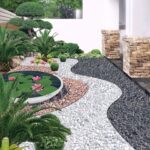Adding some plants with bright pops of color can bring life and vibrancy to any garden. Consider planting flowers such as marigolds, petunias, or impatiens to add a splash of color to your landscaping. You can also mix in some colorful foliage plants such as coleus or ornamental grasses to create visual interest.
Incorporating different levels of height into your garden can enhance the overall look and feel of the space. Planting taller shrubs or trees in the background can create a sense of depth, while shorter plants in the foreground can add texture and dimension. Layering plants of varying heights can also help create a cohesive and visually appealing design.
Adding a focal point to your garden can help draw the eye and create a sense of balance. Consider adding a statement piece such as a statue, fountain, or trellis to serve as a focal point in your landscaping. You can also use a large plant or tree as a focal point, strategically placing it in a prominent location to anchor the rest of the garden.
Creating distinct areas within your garden can help maximize the use of space and create different zones for relaxing or entertaining. Consider dividing your garden into separate areas such as a dining area, seating area, or herb garden. You can use plants, hedges, or fences to create boundaries between these different zones, giving each area its own unique character.
Adding lighting to your garden can help create a cozy and inviting atmosphere, especially in the evenings. Consider installing outdoor lighting such as string lights, lanterns, or pathway lights to illuminate your garden and highlight its best features. You can also use lighting to accentuate certain plants or architectural elements, adding another layer of visual interest to your landscaping.
Incorporating sustainable and eco-friendly practices into your garden can help reduce your environmental impact and create a healthier ecosystem. Consider planting native plants, using organic fertilizers, and practicing water conservation techniques such as drip irrigation or rainwater harvesting. By taking a more sustainable approach to landscaping, you can create a beautiful garden that is not only aesthetically pleasing but also environmentally friendly.
















